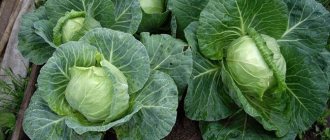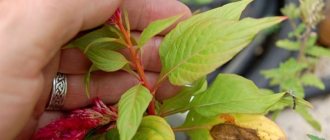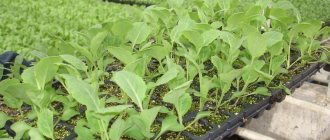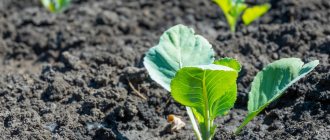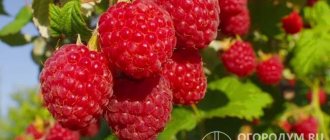- "Krautkaiser F1"
- "Guarantor F1"
Despite the year-round presence of white cabbage on store shelves and its affordable price, many gardeners include this vegetable crop as a must-have and continue to grow it on their own plots. When choosing cabbage varieties, it is important to take into account their zoning, ripening time and purpose of the heads of cabbage.
Among the varieties of white cabbage, you can choose options for every taste
The list of cabbage varieties and hybrids is extremely extensive. It presents:
- early ripening, having a short consumption period;
- mid-season, suitable for all methods of processing and short-term storage;
- late, with high shelf life and transportability, ensuring the consumption of fresh vegetables from the second half of autumn to spring.
General description of cabbage and its place in the plant classification system
Cabbage is a familiar and widespread vegetable that was grown, eaten, and used for medicinal purposes back in the Ancient World. It belongs to the cabbage family of plants, which includes not only annual and perennial herbs, but even shrub and subshrub forms. The family consists of hundreds of genera and thousands of species. Among the closest relatives of cabbage are turnips, rutabaga, mustard, rapeseed, horseradish, turnips and many others. All cabbage plants have a tap root system and simple leaves. Their flowers are collected in inflorescences, and the fruit is a pod.
The genus Cabbage has more than 50 species. Wild forms of the plant are common in the Mediterranean, Central Europe, Central and East Asia. There are none in America: they cultivate varieties brought from Europe.
Varieties of cabbage
There are 13 types of cabbage cultivated in the Russian Federation. This is evidenced by the State Register of selection achievements approved for use on the territory of the Russian Federation. Each species is divided into different varieties. In Russia, cabbage forms are mainly common, but gradually other varieties are becoming popular.
The most common type is white cabbage.
White cabbage is the most familiar, popular and widely available variety of crop in our latitudes. Its prevalence is evidenced by the large number of varieties represented in the State Register - more than 400. All of them have the main characteristic feature - a round and large fruit, which is formed from leaves in the center of the rosette.
Thanks to its composition, the beauty of cabbage, when consumed regularly, helps prevent diseases of the gastrointestinal tract, kidneys, heart, and normalizes sleep
The color of white cabbage ranges from almost white to dark green. The vegetable is rich in B vitamins, carotene, ascorbic acid, fructose, fiber, potassium, calcium and a number of other useful elements. The varieties differ in terms of ripening; almost all tolerate low temperatures well, but are demanding in terms of nutritional value and soil moisture.
White cabbage is versatile in use. It can be eaten raw, stewed, boiled, baked, fermented, pickled. There are traditional dishes that cannot be prepared without cabbage - cabbage soup and borscht. Late varieties are perfectly stored, which allows you to extend the period of consumption of fresh, nutritious vegetables.
When consumed fresh, white cabbage is an excellent source of ascorbic acid, and this makes the vegetable an excellent means of combating winter vitamin deficiency.
Fresh juice from white cabbage promotes the healing of wounds of the stomach and duodenum, as it contains anti-ulcer vitamin U.
Red cabbage
Red cabbage is the closest relative of white cabbage and differs from it only in color. The fork has a red-violet color, both outside and inside. Only the veins and the stalk of the head of cabbage are painted white. Cabbage has such an unusual color due to a special pigment - cyanidin.
Red cabbage was bred by Western European breeders in the 16th century; it came to Russia in the 17th century under the name “blue cabbage.”
To form pigment, the vegetable needs good lighting. In the shade, the leaves lose their color and the forks form poorly. In addition to lighting, red cabbage places high demands on nutritional value and soil moisture. But the crop tolerates low temperatures well.
Red cabbage has very dense heads that store well until spring.
More than 40 varieties of this species are registered in the State Register of Breeding Achievements. They differ in terms of ripening (from early to late), yield, and leaf color. Red cabbage is used primarily fresh for preparing vitamin-rich salads. This variety has certain disadvantages:
- coarser leaves compared to white cabbage;
- unappetizing, brown-gray appearance after heat treatment.
But there are many more positive qualities:
- it is stored for a long time,
- does not lose its attractive color during pickling and fermentation;
- Regular consumption of red cabbage normalizes pressure and acidity of the stomach, strengthens the walls of blood vessels, improves metabolism;
- Red cabbage is much richer than white cabbage in terms of vitamin C (almost 2 times) and carotene (almost 4 times).
When pickling red cabbage, you can use bay leaf, black pepper, cloves and even cinnamon, which interestingly complements the taste and aroma of the vegetable.
Savoy beauty
If white cabbage is often called the lady of the cabbage family, then Savoy gardeners have nicknamed the aristocrat. Its almost perfectly round head has a ruffled dark green cape of curly, blistered leaves with white veins. It is unusually beautiful, so it is often used not only for making forks, but also for decorating a personal plot.
Due to their corrugation, heads of Savoy cabbage are quite loose and have little weight.
Savoy cabbage has long taken root in European gardens, but in Russia it has not yet gained the popularity it deserves.
Savoy cabbage is grown in the same way as white cabbage. It is frost-resistant and not afraid of drought. It should be noted that corrugated cabbage leaves are not very popular with pests.
Selectively harvesting heads of early varieties of Savoy cabbage begins in July, and late varieties - in October
In addition to its attractive appearance, Savoy cabbage has a rich composition, which makes it indispensable in the diet. The taste of the leaves and head of cabbage is very delicate, slightly sweet. The culture is great for making cabbage soup, salads, and cabbage pies. Due to its looseness, the head of the vegetable can be easily disassembled, so preparing cabbage rolls in savoy cabbage leaves is easy; they turn out tender and juicy.
Savoy has very delicate leaves, so they make excellent cabbage rolls
Brussels sprouts
This variety can be called the rarest cabbage in our gardens. It is quite exotic: miniature bright green heads of 4–5 cm in size form on a long stem. Up to 40 heads can ripen on one plant.
The stem of Brussels sprouts, up to 60 cm high, is completely covered with mini-heads the size of a walnut.
The culture is distinguished by a long growing season. Even with early sowing of seeds, the harvest does not ripen until the end of September. The ideal conditions for Brussels sprouts are long, cool summers and moderate humidity. This variety of cabbage has some growing features:
- it cannot be hilled, since the largest heads of cabbage are tied near the ground, at the bottom of the stem;
- plants of tall varieties need support;
- Brussels sprouts do not tolerate dense plantings;
- To make the buds grow larger, pinch the top of the plant and cut off the leaves.
The tastiest heads of Brussels sprouts are those that are still closed but have already reached the desired size.
Despite their late ripening, Brussels sprouts have many advantages:
- frost resistance;
- low maintenance requirements;
- contains much more amino acids and vitamins than white cabbage;
- excellent preservation;
- versatility in use. Heads of cabbage are placed in salads, they can be fried, added to soups, stewed, or frozen.
Brussels sprouts have a spicy, nutty flavor due to the mustard oils they contain.
Broccoli
Broccoli's unopened bright green florets are also eaten. Look at the photo - another two or three days and the dense head will turn into a rosette of cheerful, but completely inedible flowers. It's time to harvest!
Broccoli is the record holder for vitamin A content among other types of cabbage crops. It's also full of vitamins (especially vitamin C) and antioxidants.
Broccoli makes amazing puree soups, casseroles, and salads. But gourmets prefer to savor its exquisite nutty taste separately from other products. Of course, when fresh it is a bit harsh, but if you steam the flowers for 10 minutes, all the benefits will remain and it will be easier to chew.
Broccoli also requires abundant feeding and watering throughout the summer season . Try not to thicken the plantings: on some packages of seeds it is recommended to leave a distance of only 30 centimeters between plants, but this is completely wrong. The best planting pattern for broccoli is 40 x 60 or even 50 x 60 centimeters.
And if you wait 7-10 days after harvesting the central flower heads, then an additional crop of mini-inflorescences will grow on the side shoots. I generally leave the broccoli in the garden until the end of October and gradually collect the side flowers.
Decorative types - decorating the garden
Green, yellow, white, purple with various shades and color combinations, decorative cabbage is a worthy decoration for the most sophisticated flower beds. This variety of cabbage is used for autumn decoration of the site, when most flowers have already ended the growing season.
An interesting feature is the fact that autumn frosts do not destroy plants, but make them brighter and more expressive.
The State Register of Breeding Achievements includes 12 varieties of this plant with a description of not only decorative properties, but also nutritional value. It turns out that you can make salads from ornamental cabbage; its leaves are pickled and frozen. They taste a little bitter and have a rough structure, but are extremely rich in nutrients. For example, selenium is an element that regulates the activity of the immune system. The greenery of ornamental cabbage contains three times more of it than other types.
You can have fresh leaves of this crop all winter. To do this, it is enough to dig up a bush of the plant in the fall and transplant it into a large container. Decorative cabbage will decorate your room and its fresh greens will always be at hand.
Photo gallery: ornamental cabbage in garden plots
Ornamental cabbage, this spectacular two-year-old plant, is propagated by seeds, which can be purchased at the market or in a specialty store.
Ornamental cabbage grows well in large flowerpots or pots
To transplant, decorative cabbage is dug up with a lump of earth and transferred to a new place.
Ornamental cabbage is a cold-resistant plant that does not suffer from spring-autumn temperature changes
Experienced gardeners recommend planting ornamental cabbage seedlings first in inconspicuous beds and then moving them to the flowerbed only when the flower reaches its maximum beauty
Using decorative cabbage, you can easily create beautiful hanging and vertical flower beds
Using various shrubs, perennials and ornamental cabbage, you can create various amazing compositions
Ornamental cabbage is not afraid of cold, the plant will please the eye even at -10 ⁰С, while only enhancing the intensity of color
Kohlrabi
The name of this variety of cabbage consists of two German words: koil - cabbage and ribe - turnip. Its stem fruit actually somewhat resembles a turnip. The plant itself is compact, consisting of a root, a thickened stem and a small number of elongated and upward-pointing leaves. The State Register of Breeding Achievements recommends about 30 varieties of vegetables for cultivation in the Russian Federation. They differ in ripening time (from early to late ripening), fruit weight (from 0.3 to 3 kg), peel color (from white to dark purple).
Among kohlrabi there are varieties with green, yellow, snow-white and purple colors.
Kohlrabi, like other varieties of cabbage, is grown by sowing seeds in the ground or through seedlings. It does not impose any special maintenance requirements, with the exception of soil breathability. Only in loose soil do tender and juicy stem fruits ripen, but if they are not removed in time, the pulp can harden and become fibrous.
Kohlrabi will grow in soils of any composition, except acidic and depleted ones, in which the stem fruits grow coarsely fibrous and hard
The taste of the vegetable resembles the stalk of white cabbage, but without the bitterness. The stem fruit contains a number of vitamins, a lot of potassium and calcium, fructose and glucose. This variety of cabbage is recommended for diabetics. It is universal in use. Delicious puree soups are prepared from kohlrabi; the fruit can be stuffed, pickled, and added to salads. The stem fruit is perfectly stored in a dry and cool room.
Video: the best way to eat kohlrabi
Colored
The most common type of cabbage after white cabbage. Cauliflower, like Romanesco, which belongs to this group, has become very popular recently. Coloring ranges from boiling white to purple. Light green colored heads are also found.
Unlike other species, cauliflower is very demanding on growing conditions.
If there are changes in the irrigation regime or temperature fluctuations, it will not be possible to obtain a full harvest. To obtain good results, cauliflower is grown through seedlings.
Cauliflower varieties, description:
Express
Express
- Precocious.
- The rosette is large in size, up to half a kilogram.
- The inflorescence is white, slightly raised on the stalk.
- The value of the variety lies in its high degree of resistance to various diseases.
Cheddar F1
Cheddar F1
- Mid-early variety.
- The head is rich yellow in color due to its carotene content.
- Weight from 1 to 2 kg.
- Romanesco Emerald Cup
- Heads weighing from 300 to 500 g.
Cucumbers: description of 29 varieties, main characteristics and gardener reviews about them | (Photo & Video)
Kale
There are 6 varieties of fodder cabbage grown in Russia, but only one is registered in the State Register of Breeding Achievements - Vekha. This is a plant consisting of a powerful and succulent stem, which can reach a height of 2 m and large, ovate-elongated leaves. Their color can be simply green or have a purple tint.
Due to its powerful root system, cabbage can tolerate short-term drought.
The feed value of this variety of cabbage is very high: it surpasses all fodder root vegetables and corn in nutritional value, and can be equated to an oat mixture. The crop is in demand in various branches of livestock farming: it is happily eaten by cattle, pigs, chickens and ducks.
The vegetable is unpretentious to grow and tolerates frost well. Heat and excessive dryness of the soil can stop its growth. The main growth of the crop occurs in autumn, and given that an adult plant can easily withstand frosts down to -10 degrees, it can be harvested in November, that is, the consumption of green feed by livestock can be extended for a long time.
The crop yield is very high - up to 800 kg per hundred square meters.
Pest Control
It is advisable to carry out preventive measures to combat pests almost immediately after planting seedlings in the ground. Periodically pollinate the soil with wood ash or tobacco dust, place marigolds or spring garlic next to the cabbage. Fir oil is highly effective in preventing the appearance of insects. Dissolve 10 drops of the drug in 1 liter of water and water the cabbage over the leaves.
It is highly undesirable to use chemicals to protect cabbage from pests. Caterpillars, aphids, slugs and snails can also be dealt with using folk remedies. An infusion of tomato tops is effective. To do this, 2 kg of tops are mixed with 5 liters of water and left overnight. Next, the infusion is boiled for 2 hours. After cooling, strain and dilute with water until the volume doubles. You can immediately spray the cabbage with the prepared product. For good adhesion to foliage, it is necessary to add half a bar of laundry soap, grated, to the resulting composition.
Preparation of tomato tops infusion
An infusion of onion peels will also help fight pests. To make it, you need to pour 2 liters of boiling water into a liter jar of husks and leave for 24 hours. Strain, squeeze. After this, bring the volume of liquid to 10 l, add 1 tbsp. l. a spoonful of liquid soap. You can spray any plants.
Greens or vegetables - types that look like grass
When you see some varieties of cabbage, you might mistake them for grass. The unusual shape gives only an external difference from the usual heads of cabbage, and all the “cabbage” features are characteristic of such original species.
Chinese cabbage
This variety of crop does not form a head of cabbage or a root crop. It's more like a salad than traditional cabbage. The State Register of Breeding Achievements identifies it as a separate species and recommends 17 different varieties for cultivation. Chinese cabbage (or pak choi) is a vegetable crop consisting of elongated oval, bright green leaves on thick petioles.
Pak choy is harvested throughout the season, before frost.
The main advantage of Chinese cabbage is its early ripening. Its early varieties have a very short growing season: literally a month after planting, the leaves and petioles of the plant can be eaten. At the same time, the vegetable does not make any special demands on soil fertility and temperature conditions.
Chinese cabbage can be grown and produce a good harvest when planted at home.
Another important virtue of culture is usefulness. It contains a huge list of vitamins, microelements such as phosphorus, iron, potassium, calcium, sodium and magnesium. Chinese cabbage is especially valuable because it contains a large amount of lysine, which helps cleanse the blood. In China, this vegetable is considered a source of longevity.
Chinese cabbage greens are not stored for a long time, so it is better to use them immediately for cooking.
China leaves will be tender, juicy and extremely tasty if they are removed in time, avoiding yellowing. Leaves no longer than 25–30 cm in length are considered ideal for harvesting. They are used in borscht, salads, and are excellent for making cabbage rolls. Cabbage petioles, which make up almost half of the vegetable, are also eaten.
Recent Entries
Lilac perennials that are beautiful, compact and do not crowd out other plants Why when buying seedlings you should not take the sellers’ word for it and how to determine the age of the plant using 3 signs Tomato seedlings have turned purple or whitish: why the color has changed and how to save the plants
Unusual kale
Kale does not form a head. Its beautiful, carved and long leaves can be of varying degrees of curl and different colors - from green to dark purple. The height of the plant depends on the variety and ranges from 30 to 90 cm.
This variety of cabbage is grown for various purposes. Someone decorates their plot with it - after all, the decorative properties of kale are noted in the State Register of Breeding Achievements. This species also has high nutritional qualities. Cabbage leaves are added to salads, they can be stewed with meat, used as a side dish, salted, pickled, baked, or used as a filling for pies. The young leaves of the plant are especially tasty. The petioles and central veins of an adult vegetable become rough and fibrous.
Two varieties of kale are included in the State Register:
- Redbor;
Redbor is a late-maturing, excellent quality hybrid of kale with curly, dark purple leaves.
- Reflex.
Kale variety Reflex is distinguished by openwork gray-green leaves that have a low predisposition to yellowing
Popular varieties also include red and green kale. All varieties of kale tolerate low temperatures well - plants do not die even at -15 degrees. After exposure to frost, the leaves become sweeter and more aromatic.
Cabbage leaves go well with onions, tomatoes, dill, parsley
Exotic Japanese cabbage
Japanese cabbage is widespread in its homeland just like white cabbage in our country. This is a leaf type cabbage and does not form inflorescences. Its corrugated or smooth leaves have torn edges and are heavily dissected. Externally, the plant does not look at all like cabbage, but judging by how quickly the main cabbage pest, the cruciferous flea beetle, finds it, there is no doubt that the spreading leafy bush presented below belongs to the cabbage family.
Even a novice gardener can grow Japanese cabbage, as it is unpretentious, heat- and cold-resistant
Japanese cabbage is a rare guest in our beds. But it deserves the attention of gardeners both for its decorativeness and usefulness. The culture is classified as a dietary product recommended for the prevention and treatment of cardiovascular diseases and diseases of the gastrointestinal tract. Since the plant has early ripening periods, it can be actively used for spring vitamin deficiency.
Japanese cabbage can be harvested several times per season. After cutting, it grows new leaves quite quickly.
Japanese can be added to salads, stewed with other vegetables, and used in making soups. Its unusual leaves can serve as the basis and decoration for sandwiches.
Leafy (kale)
This original subspecies is decorative and edible. Popular varieties are those with a basal rosette of fleshy, bubbly leaves (Dino, Black Tuscany), as well as “palm trees” with spreading curly foliage on a thick stem 0.4–2 m high (Red Kale, Lark’s Tongue, Reflex F1, Redbor F1). Commercial yield – up to 7 kg/sq.m. The peculiarity of the vegetable is that it is rich in protein, calcium, potassium, and omega-3 acids. It can be eaten raw, boiled and stewed. Plants are demanding of organic nutrition and moisture supply. Decorate the garden until late autumn.
Chinese cabbage
Chinese cabbage is similar to cabbage and lettuce at the same time. Its succulent leaves with jagged edges form a rosette, in the center of which an elongated, cone-shaped, loose head of cabbage is formed. The tender parts of the leaves are most often colored light green, and the bottom of the rosette and the veins are white.
Not long ago, red Chinese cabbage with purple leaves appeared. The presentation of this variety is unusual and unique.
Typically, the weight of a head of Chinese cabbage ranges between 1 kg
Pekinka gained its popularity due to its precocity and usefulness. Growing it is not at all difficult, the main thing is to sow it on time and follow the rules of caring for the plant. Culture reacts sharply to the length of the day. With late spring sowing, poor soil and lack of moisture, it can shoot an arrow.
Peking cabbage is ideal for growing in greenhouses and open ground, and is no more troublesome than its white cabbage cousin.
Chinese cabbage is rich in various vitamins; it has a particularly high content of ascorbic acid and carotene. The taste of Peking is very delicate, it combines the taste of lettuce and cabbage. The vegetable has juicy, crispy, elastic leaves, which are great for preparing first and second courses, salads; they can be pickled, salted and even dried.
Video: Chinese cabbage and its benefits
Inflorescence instead of a head of cabbage
Broccoli, cauliflower - the names are familiar to everyone. In some ways they are similar, but there are also differences.
Cauliflower
Cauliflower can be ranked second in popularity after white cabbage. It has a thick branched stem, around which dense, numerous inflorescences form. Most often they have a white or yellowish-cream tint. Recently, many new varieties have been developed that have different colors: pink, purple and even orange.
Nowadays, cauliflower is widespread and cultivated throughout Europe, South and North America, China and Japan.
The State Register of Breeding Achievements recommends more than 150 varieties of this variety for cultivation. Among the variety offered, you can select varieties that are suitable in terms of ripening time, yield and care characteristics. When growing cauliflower, the following nuances must be taken into account:
- the plant loves fertile soil;
- Cabbage heads should be shaded. If exposed to direct sunlight, the inflorescences may get burned, which will lead to the appearance of brown spots;
- cabbage is frost-resistant, but at temperatures below +10 degrees it does not set inflorescences;
- the plant does not tolerate heat and drought;
- heads overexposed in the beds become loose and tasteless.
Cauliflower is rich in protein, potassium, calcium, iron, phosphorus, and a number of vitamins. It is known for its hypoallergenicity and dietary qualities, therefore it is recommended even for the first feeding of infants. In cooking, cauliflower is used both as an independent dish and in combination with other vegetables. It can be fried, boiled, baked, pickled, frozen and even salted.
It’s impossible not to love the rosy, aromatic, crispy outside and tender inside fried cauliflower coated in cheese!
When preparing dishes from cauliflower, it should be taken into account that with prolonged heat treatment the vegetable loses some of its beneficial properties.
Picturesque Romanesque
Romanesco is a variety of cauliflower. This is an interesting and unusual form, which is distinguished by its softness and tenderness of texture and taste, as well as decorativeness. Romanesco buds are arranged in a spiral and form pointed inflorescences.
Romanesco cabbage (Italian romanesco - Roman cabbage) - is the result of breeding experiments by crossing cauliflower and broccoli
The taste of Romanesco is pleasant, creamy and nutty without bitterness. Like regular cauliflower, it can be stewed, fried, or pickled. Due to its exquisite shape, the vegetable is often used to decorate dishes.
Video: Romanesco cabbage - a super food you haven't tried
Healthy broccoli
Recently, gardeners are increasingly planting this variety of cabbage on their plots. The growing popularity is explained by the culture’s unpretentiousness to growing conditions and a rich set of useful substances. You can plant it early, since broccoli easily tolerates cold weather, it is undemanding in terms of watering and soil fertility. In the first year, a large number of peduncles with dense groups of small buds at the ends are formed on the thick central trunk of broccoli. Together the peduncles form a small, loose head. Overgrown broccoli inflorescences can have a green color and its shades; there are varieties with purple and white buds.
In appearance, broccoli is similar to cauliflower, but the developing heads most often have a pronounced green color and are small in size.
The head of broccoli is cut off when it reaches a diameter of 10–17 cm and the buds have not begun to develop into flowers. With proper cutting (at the base above the leaves), new inflorescences will begin to develop from the lateral buds. They will not grow as large as the central head, but they will not be inferior to it in taste and beneficial properties. Thus, the fruiting of broccoli can be extended over several months.
The yellow color of broccoli buds is evidence that the cabbage is overripe and not suitable for consumption.
Broccoli must be harvested before the green buds open and turn into yellow flowers.
Broccoli has a high content of useful elements: vitamins, microelements, protein and fiber. Eating vegetables has a beneficial effect on the body's performance; it has an antioxidant effect and helps remove toxins.
It is not recommended to store freshly cut cabbage heads for a long time - they quickly lose their usefulness. Freezing vegetables helps preserve vitamins and other useful elements.
Broccoli does not require long-term heat treatment. It is steamed or blanched. This variety of cabbage is used in salads, soups, casseroles, vegetable stews, and can be preserved with rice and other vegetables.
Fried broccoli in batter is not only very tasty, but also looks very impressive.
Broccoli is one of the best dietary foods: 100 g of vegetable contains only 34 kcal.
Brussels
Types of Brussels cabbage (photos with names can be seen in various sources) are distinguished by their original appearance. It is a thick stem to which tiny heads of cabbage are attached, ranging from 20 to 40 pieces. Brussels sprouts are valued by vegetable growers for their excellent taste and ability to easily tolerate moisture deficiency.
The most popular varieties are:
| Name of variety or hybrid | Description and characteristics | pros | Minuses |
| Hercules | A late-ripening variety that requires at least 140 days to ripen. Feels great in frosts down to -10° C, but does not tolerate heat. The heads of cabbage are loose, medium in size, slightly elongated | · high yield from 1 bush: on average – up to 30 fruits; Possibility of use in preparing various dishes | Requirement for care |
| Bunch of grapes | Late-ripening cabbage (vegetative period - 160 days), the spherical heads of which are in the amount of 35-40 pieces. have a purple color | · delicate taste with nutty notes; · unpretentiousness; · transportability; · attractive presentation | Sometimes there is a bad connection of swings |
| Sapphire | Drought-resistant, beautiful variety, distinguished by intense color and neat arrangement of absolutely identical heads of cabbage in the amount of 30-35 copies. The plant takes 120 days to ripen; harvesting occurs when the fruit reaches a diameter of 30-40 mm | Excellent taste | The plant does not develop well in the shade |
Cabbage that is not cabbage
Very often we call cabbage plants that have nothing to do with the family of the same name. Among them are iceberg lettuce and seaweed.
Iceberg lettuce
Iceberg - lettuce. Its light green leaves, slightly jagged along the outer edge, are rolled into small, round, but loose heads, reminiscent of white cabbage. This plant is native to California.
Iceberg lettuce does not require special conditions for growth and is easy to grow in a garden plot, cottage or windowsill
According to some reports, this form of salad got its name due to the fact that to maintain freshness, the salad was transported in containers with ice. Other sources attribute the name to the eucalyptus, refreshing aftertaste of the salad.
Iceberg tastes similar to lettuce, but due to its juiciness it has a pleasant crunch that is not typical of lettuce crops. Iceberg is recommended to be included in the menu not only for adults, but also for children. It can relieve symptoms of fatigue, have a positive effect on the activity of the gastrointestinal tract and cardiovascular system, and improve the condition of vision and skin.
The crispy head of Iceberg lettuce does not have a very dense structure.
Iceberg can only be used in its raw form, since during heat treatment it loses not only its beneficial properties, but also its visual appeal.
Sea kale
Sea kale has nothing to do with cabbage. This is a seaweed called kelp. Since time immemorial, it has been used in the diet of those people who live near the sea. Laminaria is common in the White, Kara, Okhotsk and Japanese seas. In places with a constant flow, algae form dense thickets along the banks. Its plates are brown in color, and their length varies from a few centimeters to 20 m.
Large underwater “algae forests” of kelp usually form at a depth of 4-10 m
The product received its popular name for its similarity to shredded leaves of ordinary white cabbage that have undergone heat treatment.
There are a huge number of varieties of kelp, but only 2 types are used for food: sugary and Japanese. They have a pleasant taste and soft consistency. Other species are also used by humans, but as technical raw materials and for medical purposes.
Seaweed contains proteins, amino acids, and a number of vitamins necessary for the human body. Of particular value is the content of a record concentration of iodine in a bioavailable form. The rich composition makes seaweed both a healthy food and an affordable medicine. You can use seaweed in any form: dried, frozen, fresh or dried.
It is recommended to purchase not ready-made salads, but dried seaweed. It is very useful because it only loses excess moisture, but completely retains vitamins and microelements. Dry seaweed is very convenient because you can make a salad from it at any time or serve it with any dish.
Possessing many beneficial properties, a powerful charge of vitamins, minerals, micro- and macroelements, kelp should be present in our diet in reasonable quantities.
Video: growing and harvesting all types of cabbage
Once you get acquainted with the main types of cabbage and some of their characteristics, you can choose the most suitable variety for yourself. Planting beds with a unique vegetable will help create a unique decor on the site. We hope that tasting organic cabbage delicacies grown in your own garden will bring you true joy and pleasure.
- Author: Lyudmila Bartasevich
My name is Ludmila. Higher education, graduated from the Minsk Institute of Culture. I live in Belarus. Rate this article:
- 5
- 4
- 3
- 2
- 1
(15 votes, average: 3.2 out of 5)
Share with your friends!
Adviсe
The fair half of humanity will certainly be interested in the possibility of using cabbage in cosmetology. Here are just some recommendations:
- Anti-pigmentation. Rub the skin with vegetable oil, preferably olive or jojoba, then chop the white cabbage in a blender and apply the resulting pulp to the prepared face. After 20 minutes, rinse with hot water.
- Against acne. Grind the cabbage leaves, add a little hydrogen peroxide and lemon juice. Apply for 5-7 minutes, rinse with warm or cool water. Apply the mask 3-4 times a week.
- Cabbage leaves can simply be washed and applied to the face in its pure form for half an hour. If this procedure is carried out regularly, then very soon you will notice that the skin has become cleaner and the sebaceous sheen has decreased.
For an overview of cabbage varieties, see the following video.
